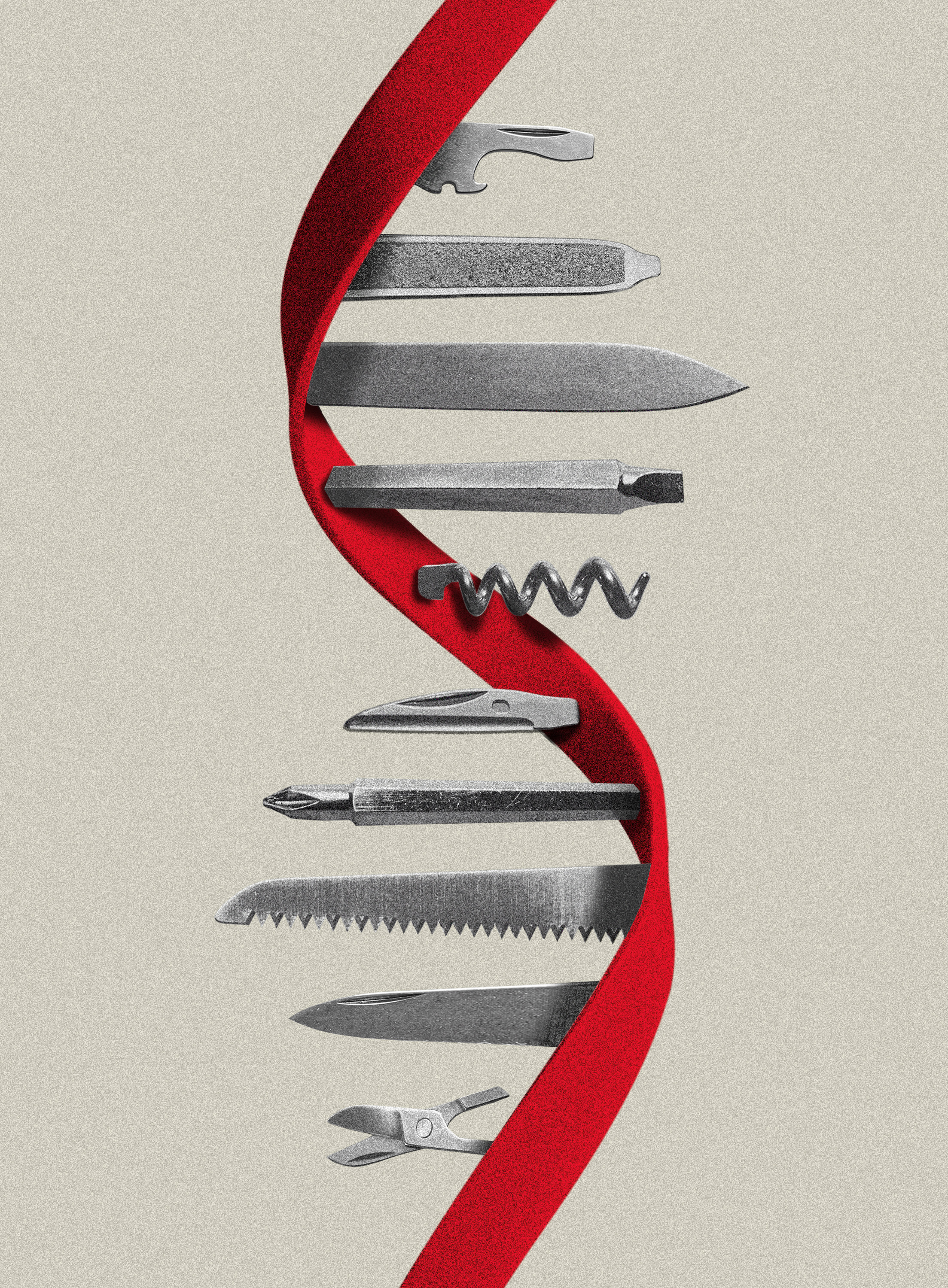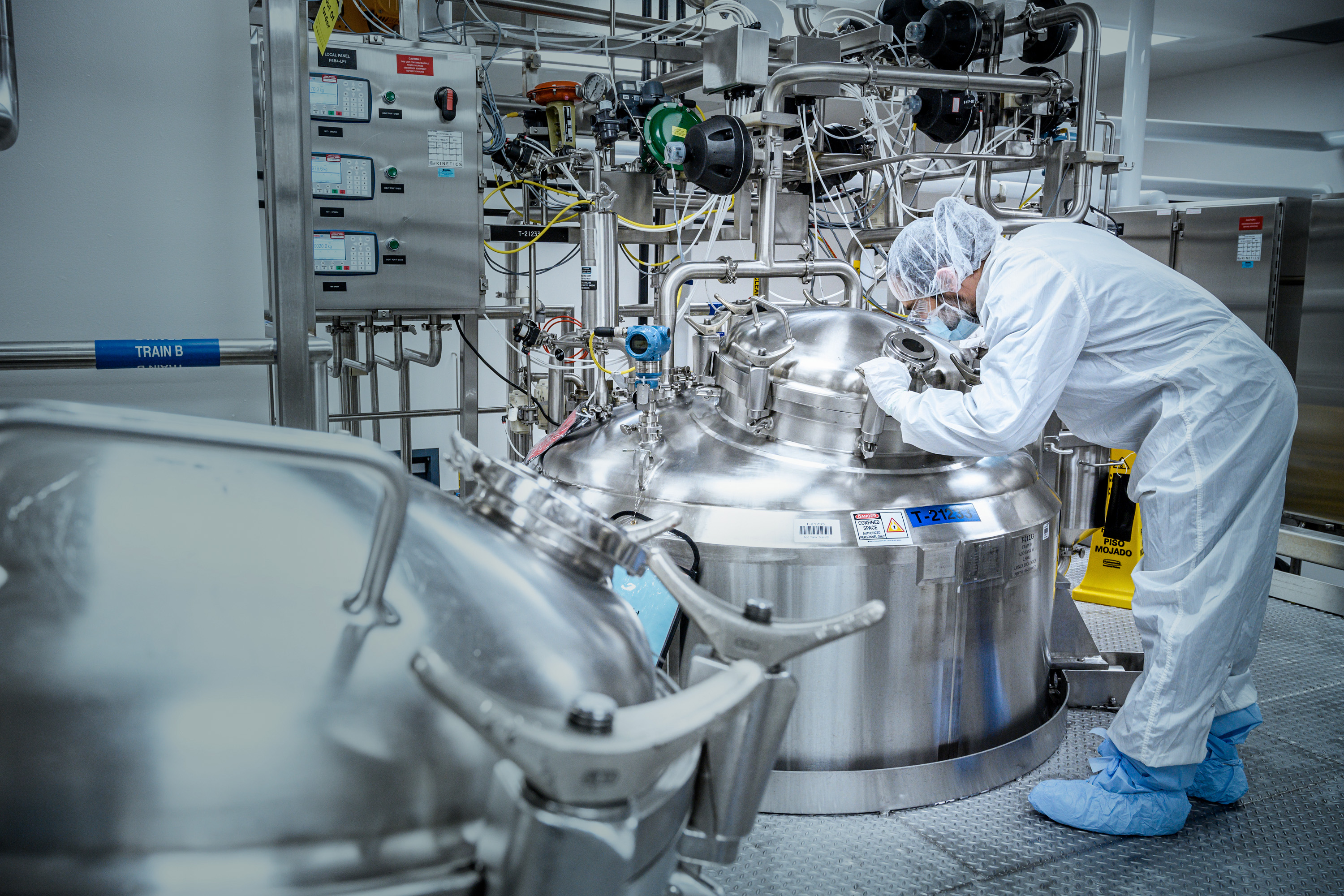The next act for messenger RNA could be bigger than covid vaccines
New messenger RNA vaccines to fight the coronavirus are based on a technology that could transform medicine. Next up: sickle cell and HIV.

On December 23, as part of a publicity push to encourage people to get vaccinated against covid-19, the University of Pennsylvania released footage of two researchers who developed the science behind the shots, Katalin Karikó and Drew Weissman, getting their inoculations. The vaccines, icy concoctions of fatty spheres and genetic instructions, used a previously unproven technology based on messenger RNA and had been built and tested in under a year, thanks to discoveries the pair made starting 20 years earlier.
Why it matters:
Worldwide, more than 2 million have died from covid-19. Vaccines based on mRNA are roughly 95% effective.
Key players:
• BioNTech
• GreenLight Biosciences
• Moderna Therapeutics
• Pfizer
• Strand Therapeutics
Availability:
Now
In the silent promotional clip, neither one speaks or smiles as a nurse inserts the hypodermic into their arms. I later asked Weissman, who has been a physician and working scientist since 1987, what he was thinking in that moment. “I always wanted to develop something that helps people,” he told me. “When they stuck that needle in my arm, I said, ‘I think I’ve finally done it.’”
The infection has killed more than 2 million people globally, including some of Weissman’s childhood friends. So far, the US vaccine campaign has relied entirely on shots developed by Moderna Therapeutics of Cambridge, Massachusetts, and BioNTech in Mainz, Germany, in partnership with Pfizer. Both employ Weissman’s discoveries. (Weissman’s lab gets funding from BioNTech, and Karikó now works at the company.)
Unlike traditional vaccines, which use live viruses, dead ones, or bits of the shells that viruses come cloaked in to train the body’s immune system, the new shots use messenger RNA—the short-lived middleman molecule that, in our cells, conveys copies of genes to where they can guide the making of proteins.
The message the mRNA vaccine adds to people’s cells is borrowed from the coronavirus itself—the instructions for the crown-like protein, called spike, that it uses to enter cells. This protein alone can’t make a person sick; instead, it prompts a strong immune response that, in large studies concluded in December, prevented about 95% of covid-19 cases.

Beyond potentially ending the pandemic, the vaccine breakthrough is showing how messenger RNA may offer a new approach to building drugs.
In the near future, researchers believe, shots that deliver temporary instructions into cells could lead to vaccines against herpes and malaria, better flu vaccines, and, if the covid-19 germ keeps mutating, updated coronavirus vaccinations, too.
But researchers also see a future well beyond vaccines. They think the technology will permit cheap gene fixes for cancer, sickle-cell disease, and maybe even HIV.
For Weissman, the success of covid vaccines isn’t a surprise but a welcome validation of his life’s work. “We have been working on this for over 20 years,” he says. “We always knew RNA would be a significant therapeutic tool.”
Perfect timing
Despite those two decades of research, though, messenger RNA had never been used in any marketed drug before last year.
Then, in December 2019, the first reports emerged from Wuhan, China, about a scary transmissible pneumonia, most likely some kind of bat virus. Chinese government censors at first sought to cover up the outbreak, but on January 10, 2020, a Shanghai scientist posted the germ’s genetic code online through a contact in Australia. The virus was already moving quickly, jumping onto airplanes and popping up in Hong Kong and Thailand. But the genetic information moved even faster. It arrived in Mainz at the headquarters of BioNTech, and in Cambridge at Moderna, where some researchers got the readout as a Microsoft Word file.
Scientists at Moderna, a biotech specializing in messenger RNA, were able to design a vaccine on paper in 48 hours, 11 days before the US even had its first recorded case. Inside of six weeks, Moderna had chilled doses ready for tests in animals.
Unlike most biotech drugs, RNA is not made in fermenters or living cells—it’s produced inside plastic bags of chemicals and enzymes. Because there’s never been a messenger RNA drug on the market before, there was no factory to commandeer and no supply chain to call on.
When I spoke to Moderna CEO Stéphane Bancel in December, just before the US Food and Drug Administration authorized his company’s vaccine, he was feeling confident about the shot but worried about making enough of it. Moderna had promised to make up to a billion doses during 2021. Imagine, he said, that Henry Ford was rolling the first Model T off the production line, only to be told the world needed a billion of them.
Bancel calls the way covid-19 arrived just as messenger RNA technology was ready an “aberration of history.”
In other words, we got lucky.
Human bioreactors
The first attempt to use synthetic messenger RNA to make an animal produce a protein was in 1990. It worked but a big problem soon arose. The injections made mice sick. “Their fur gets ruffled. They lose weight, stop running around,” says Weissman. Give them a large dose, and they’d die within hours. “We quickly realized that messenger RNA was not usable,” he says.
The culprit was inflammation. Over a few billion years, bacteria, plants, and mammals have all evolved to spot the genetic material from viruses and react to it. Weissman and Karikó’s next step, which “took years,” he says, was to identify how cells were recognizing the foreign RNA.
As they found, cells are packed with sensing molecules that distinguish your RNA from that of a virus. If these molecules see viral genes, they launch a storm of immune molecules called cytokines that hold the virus at bay while your body learns to cope with it. “It takes a week to make an antibody response; what keeps you alive for those seven days is these sensors,” Weissman says. But too strong a flood of cytokines can kill you.
The eureka moment was when the two scientists determined they could avoid the immune reaction by using chemically modified building blocks to make the RNA. It worked. Soon after, in Cambridge, a group of entrepreneurs began setting up Moderna Therapeutics to build on Weissman’s insight.
Vaccines were not their focus. At the company’s founding in 2010, its leaders imagined they might be able to use RNA to replace the injected proteins that make up most of the biotech pharmacopoeia, essentially producing drugs inside the patient’s own cells from an RNA blueprint. “We were asking, could we turn a human into a bioreactor?” says Noubar Afeyan, the company’s cofounder and chairman and the head of Flagship Pioneering, a firm that starts biotech companies.
If so, the company could easily name 20, 30, or even 40 drugs that would be worth replacing. But Moderna was struggling with how to get the messenger RNA to the right cells in the body, and without too many side effects. Its scientists were also learning that administering repeat doses, which would be necessary to replace biotech blockbusters like a clotting factor that’s given monthly, was going to be a problem. “We would find it worked once, then the second time less, and then the third time even lower,” says Afeyan. “That was a problem.”
Moderna pivoted. What kind of drug could you give once and still have a big impact? The answer eventually became obvious: a vaccine. With a vaccine, the initial supply of protein would be enough to train the immune system in ways that could last years, or a lifetime.
A second major question was how to package the delicate RNA molecules, which last for only a couple of minutes if exposed. Weissman says he tried 40 different carriers, including water droplets, sugar, and proteins from salmon sperm. It was like Edison looking for the right filament to make an electric lamp. “Almost anything people published, we tried,” he says. Most promising were nanoparticles made from a mixture of fats. But these were secret commercial inventions and are still the basis of patent disputes. Weissman didn’t get his hands on them until 2014, after half a decade of attempts.
When he finally did, he loved what he saw. “They were better than anything else we had tried,” he says. “It had what you wanted in a drug. High potency, no adverse events.” By 2017, Weissman’s lab had shown how to vaccinate mice and monkeys against the Zika virus using messenger RNA, an effort that soon won funding from BioNTech. Moderna was neck and neck. It quickly published results of an early human test of a new mRNA influenza vaccine and would initiate a large series of clinical studies involving diseases including Zika.
Pivoting to vaccines did have a drawback for Moderna. Andrew Lo, a professor at MIT’s Laboratory for Financial Engineering, says that most vaccines lose money. The reason is that many shots sell for a “fraction of their economic value.” Governments will pay $100,000 for a cancer drug that adds a month to a person’s life but only want to pay $5 for a vaccine that can protect against an infectious disease for good. Lo calculated that vaccine programs for emerging threats like Zika or Ebola, where outbreaks come and go, would deliver a -66% return on average. “The economic model for vaccines is broken,” he says.
On the other hand, vaccines are more predictable. When Lo’s team analyzed thousands of clinical trials, they found that vaccine programs frequently succeed. Around 40% of vaccine candidates in efficacy tests, called phase 2 clinical trials, proved successful, a rate 10 times that of cancer drugs.
Adding to mRNA vaccines’ chance of success was a lucky break. Injected into the arm, the nanoparticles holding the critical instructions seemed to home in on dendritic cells, the exact cell type whose job is to train the immune system to recognize a virus. What’s more, something about the particles put the immune system on alert. It wasn’t planned, but they were working as what’s called a vaccine adjuvant. “We couldn’t believe the effect,” says Weissman.
Vaccines offered Moderna’s CEO, Bancel, a chance to advance a phalanx of new products. Since every vaccine would use the same nanoparticle carrier, they could be rapidly reprogrammed, as if they were software. (Moderna had even trademarked the name “mRNA OS,” for operating system.) “The way we make mRNA for one vaccine is exactly the same as for another,” he says. “Because mRNA is an information molecule, the difference between our covid vaccine, Zika vaccine, and flu vaccine is only the order of the nucleotides.”
95% effective
Back in March 2020, when the vaccine programs were getting under way, skeptics said messenger RNA was still an unproven technology. Even this magazine said a vaccine would take 18 months, at a minimum—a projection that proved off by a full nine months. “Sometimes things take a long time just because people think it does,” says Afeyan. “That weighs on you as a scientific team. People are saying, ‘Don’t go any faster!’”
The shots from Moderna and BioNTech proved effective by December and were authorized that month in the US. But the record speed was not due only to the novel technology. Another reason was the prevalence of infection. Because so many people were catching covid-19, the studies were able to amass evidence quickly.
Is messenger RNA really a better vaccine? The answer seems to be a resounding yes. There are some side effects, but both shots are about 95% effective (that is, they stop 95 out of 100 cases), a record so far unmatched by other covid-19 vaccines and far better than the performance of flu vaccines. Another injection, made by AstraZeneca using an engineered cold virus, is around 75% effective. A shot developed in China using deactivated covid-19 germs protected only half the people who got it, although it did stop severe disease.
“This could change how we make vaccines from here on out,” says Ron Renaud, the CEO of Translate Bio, a company working with the technology.
The potency of the shots, and the ease with which they can be reprogrammed, mean researchers are already preparing to go after HIV, herpes, infant respiratory virus, and malaria—all diseases for which there’s no successful vaccine. Also on the drawing board: “universal” flu vaccines and what Weissman calls a “pan-coronavirus” shot that could offer basic protection against thousands of pathogens in that category, which have led not only to covid-19 but, before that, to the infection SARS and probably other pandemics throughout history.
“You have to assume we’re going to have more,” Weissman says. “So instead of shutting down the world for a year while you make a new vaccine, we’ll have a vaccine ready to go.”


Facilities of the biopharmaceutical company Lonza in Switzerland and New Hampshire, which are helping to manufacture Moderna’s vaccine.
Last spring, Bancel began petitioning the government to pay for vast manufacturing centers to make messenger RNA. He imagined a megafactory that “companies could use in peacetime” but that could be quickly reoriented to churn out shots during the next pandemic. That would be insurance, he says, against a nightmare scenario of a germ that spreads as fast as covid but has the 50% fatality rate of Ebola. If “governments spend billions on nuclear weapons they hope to never use,” Bancel argued in April, then “we should equip ourselves so this never happens again.”
Later that month, as part of Operation Warp Speed, the US effort to produce the vaccines, Moderna was effectively picked as a national champion to build such centers. The government handed it nearly $500 million to develop its vaccine and expand manufacturing.
Beyond vaccines
After the covid vaccines, some researchers expect Moderna and BioNTech to return to their original plans for the technology, like treating more conventional ailments such as heart attacks, cancer, or rare inherited diseases. But there’s no guarantee of success in that arena.
“Although there are a lot of potential therapeutic applications for synthetic mRNA in principle, in practice the problem of delivering sufficient amounts of mRNA to the right place in the body is going to be a huge and possibly insurmountable challenge in most cases,” says Luigi Warren, a biotech entrepreneur whose research as a postdoc formed the nucleus of Moderna.
There is one application in addition to vaccines, however, where brief exposure to messenger RNA could have effects lasting years, or even a lifetime.
In late 2019, before covid-19, the US National Institutes of Health and the Bill and Melinda Gates Foundation announced they would spend $200 million developing affordable gene therapies for use in sub-Saharan Africa. The top targets: HIV and sickle-cell disease, which are widespread there.
Gates and the NIH didn’t say how they would make such cutting-edge treatments cheap and easy to use, but Weissman told me that the plan may depend on using messenger RNA to add instructions for gene-editing tools like CRISPR to a person’s body, making permanent changes to the genome. Think of mass vaccination campaigns, says Weissman, except with gene editing to correct inherited disease.
Right now, gene therapy is complex and expensive. Since 2017, several types have been approved in the US and Europe. One, a treatment for blindness, in which viruses carry a new gene to the retina, costs $425,000 per eye.
A startup called Intellia Therapeutics is testing a treatment that packages CRISPR into RNA and then into a nanoparticle, with which it hopes to cure a painful inherited liver disease. The aim is to make the gene scissors appear in a person’s cells, cut out the problem gene, and then fade away. The company tested the drug on a patient for the first time in 2020.
It’s not a coincidence that Intellia is treating a liver disease. When dripped into the bloodstream through an IV, lipid nanoparticles tend to all end up in the liver—the body’s house-cleaning organ. “If you want to treat a liver disease, great—anything else, you have a problem,” says Weissman.
But Weissman says he’s figured out how to target the nanoparticles so that they wind up inside bone marrow, which constantly manufactures all red blood cells and immune cells. That would be a hugely valuable trick—so valuable that Weissman wouldn’t tell me how he does it. It’s a secret, he says, “until we get the patents filed.”
He intends to use this technique to try to cure sickle-cell disease by sending new instructions into the cells of the body’s blood factory. He’s also working with researchers who are ready to test on monkeys whether immune cells called T cells can be engineered to go on a seek-and-destroy mission after HIV and cure that infection, once and for all.
What all this means is that the fatty particles of messenger RNA may become a way to edit genomes at massive scales, and on the cheap. A drip drug that allows engineering of the blood system could become a public health boon as significant as vaccines. The burden of sickle-cell, an inherited disease that shortens lives by decades (or, in poor regions, kills during childhood), falls most heavily on Black people in equatorial Africa, Brazil, and the US. HIV has also become a lingering scourge: about two-thirds of people living with the virus, or dying from it, are in Africa.
Moderna and BioNTech have been selling their covid-19 vaccine shots for $20 to $40 a dose. What if that were the cost of genetic modification, too? “We could correct sickle-cell with a single shot,” Weissman says. “We think that is groundbreaking new therapy.”
There are fantastic fortunes to be made in mRNA technology. At least five people connected to Moderna and BioNTech are now billionaires, including Bancel. Weissman is not one of them, though he stands to get patent royalties. He says he prefers academia, where people are less likely to tell him what to research—or, just as important, what not to. He’s always looking for the next great scientific challenge: “It’s not that the vaccine is old news, but it was obvious they were going to work.” Messenger RNA, he says, “has an incredible future.”
Deep Dive
Biotechnology and health
How scientists traced a mysterious covid case back to six toilets
When wastewater surveillance turns into a hunt for a single infected individual, the ethics get tricky.
An AI-driven “factory of drugs” claims to have hit a big milestone
Insilico is part of a wave of companies betting on AI as the "next amazing revolution" in biology
The quest to legitimize longevity medicine
Longevity clinics offer a mix of services that largely cater to the wealthy. Now there’s a push to establish their work as a credible medical field.
There is a new most expensive drug in the world. Price tag: $4.25 million
But will the latest gene therapy suffer the curse of the costliest drug?
Stay connected
Get the latest updates from
MIT Technology Review
Discover special offers, top stories, upcoming events, and more.